ULMACEAE (Akira TAKAHASHI, Joshi LAJMINA and Mitsuo SUZUKI)
Celtis tetrandra Roxb. [Plate 86]
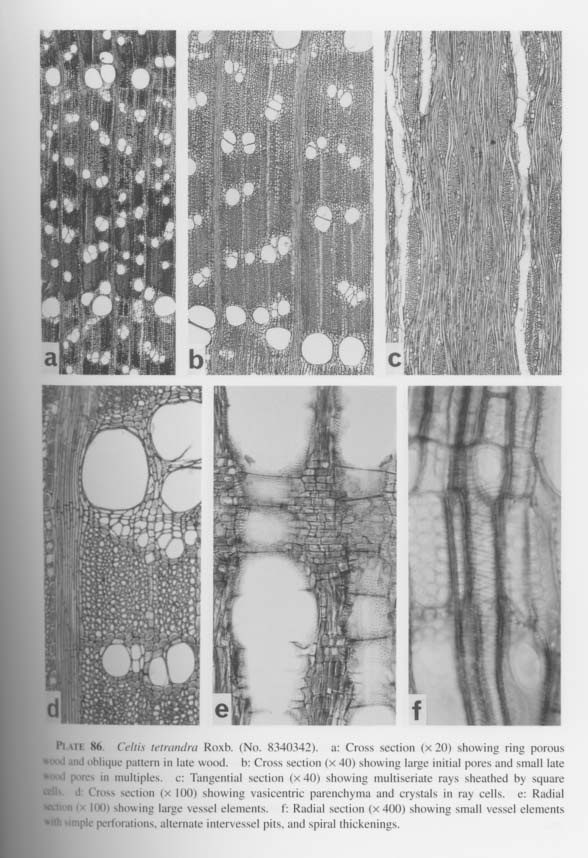
Evergreen small trees in the temperate zone.
SPECIMENS. No. 8340342*, d=40 cm, h=6 m, alt. 1880 m: Gandaki Zone, Manang Distr., Dhanagyang (2200m) − Dharapani (1800 m), H. Ohba et al., Aug. 7, 1983, No. 9194150, d=28 cm, h=6 m, alt. 1420 m: Seti Zone, Bajura Distr., Kolti (1410 m) − Bari Gad (1400 m) − Birseni (1560 m), M. Suzuki et al., Aug 11, 1991.
DESCRIPTION. Wood ring porous; growth rings distinct, delineated by the ring porosity and radially flattened tracheary elements at margin of growth rings, narrow to slightly wide, 0.2-2.7 mm. Pores few, 10-30/mm2; pore size reduced abruptly from early wood to late wood. Large pores in one row at beginning of growth rings, round, mostly solitary, occasionally in tangential and radial couples, 190-285 × 190-285 µm n diameter; small pores in late wood solitary and in multiples arranged in tangential, blique or sometimes in flame-like pattern, 40-175 × 40-160 µm in diameter; walls 2-4 µm thick.
Vessel elements fairly short, 70-280 µm; end wall nearly horizontal to moderately oblique; perforation plates exclusively simple. Intervessel pits alternate and dense, circular to polygonal, 8-12 µm in diameter, with small horizontally lenticular apertures. Spiral thickenings present on inner walls of small vessel elements. Tyloses absent.
Non-perforated tracheary elements vascular tracheids and libriform fibers. Vascular tracheids present together with small vessel elements in late wood; pits circular bordered, spiral thickenings present. Libriform fibers constituting ground mass of wood, round or polygonal in cross section, 10-30 µm in diameter, walls 2-3 µm thick; simple pits mostly on radial walls, sparse and minute slit-like; spiral thickenings absent.
Wood parenchyma abundant, vasicentric, strands mostly consisting of 2-4 cells; cells 10-40 µm in tangential diameter, 50-250 µm tall. Crystals absent.
Rays heterogeneous, uniseriate and (2)-5-10 seriate, 5-7 rays/mm in tangential section. Uniseriate rays (1)-2-10 cells and (45)-85-400 µm tall, consisting of square and upright cells. Multiseriate rays (25)-45-85 µm wide, 240-940 µm tall, consisting of procumbent, square and upright cells; central cores of procumbent cells sheathed by square and upright cells; uniseriate marginal wings consisting of 1-3 square and upright cells. Procumbent cells round or elliptic in tangential section, 10-25 × 5-15 × 40-158 µm. Square or upright cells elliptic or oblong in tangential section, 25-93 × 7-35 × 4 15-40 µm. Ray vessel pits circular or elliptic, 6-10 µm. Rhomboidal crystals fairly abundant in square and upright cells.
Trema politoria (Planch.) Blume [Plate 87]
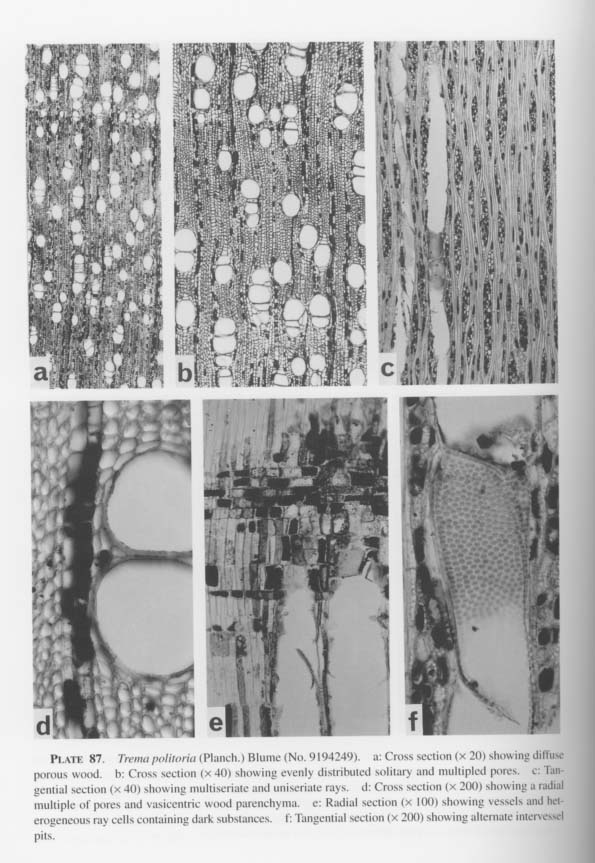
Evergreen small trees in the temperate zone.
SPECIMENS. No. 9194249*, d=14.1 cm, h=6 m, alt. 1500 m: Seti Zone, Bajhang Distr., Kinara (1390 m) − (1540 m) − Agra (1360 m) − Jaltadi (1330 m) − Bopur (1330m) − Chainpur (1310 m), M. Suzuki et al., Aug 24, 1991.
DESCRIPTION. Wood diffuse porous; pores almost same in pore size throughout the wood. Growth rings fairly indistinct, delineated by radially flattened tracheary elements, slightly wide, 2.5-4 mm. Pores evenly distributed, few 8-20 /mm2, solitary and in radial multiples of 2-5. Solitary pores round to oval in outline, small, 90-250 × 60-200 µm; walls 2-4 µm thick.
Vessel elements short, 240-510 µm; end walls moderately oblique; perforation plates exclusively simple. Intervessel pits alternate and dense, circular or polygonal, 5-10 µm in diameter, with small lenticular apertures, sometimes coalescent. Spiral thickenings absent. Tyloses present.
Non-perforated tracheary elements libriform fibers, constituting ground mass of wood, round or polygonal in cross section, 5-30 µm in diameter; walls 2-3 µm thick; simple pits mostly on radial walls, sparse and minute slit-like; spiral thickenings absent.
Wood parenchyma fairly abundant, vasicentric; strands mostly consisting of 3-9 cells; cells 20-50 µm in tangential diameter, 50-130 µm tall. Crystals absent.
Rays heterogeneous, uniseriate and 2-5 seriate, 10-16 rays/mm in tangential section. Uniseriate rays 1-12 cells and 45-590 µm tall, consisting of square and upright cells. Multiseriate rays 30-65 µm wide, 175-850 µm tall, consisting of procumbent, square, and upright cells, with uniseriate marginal wings of 1-4-(8) cells. Procumbent cells elliptic or polygonal in tangential section, 10-35 × 7-25 × 40-100 µm. Square and upright cells elliptic or oblong in tangential section, 30-95 × 8-35 × 25-45 µm. Ray vessel pits circular or elliptic, 4-15 µm. Dark gum present in ray cells. Crystals absent.
Trema tomentosa (Roxb.) H. Hara [Plate 88]
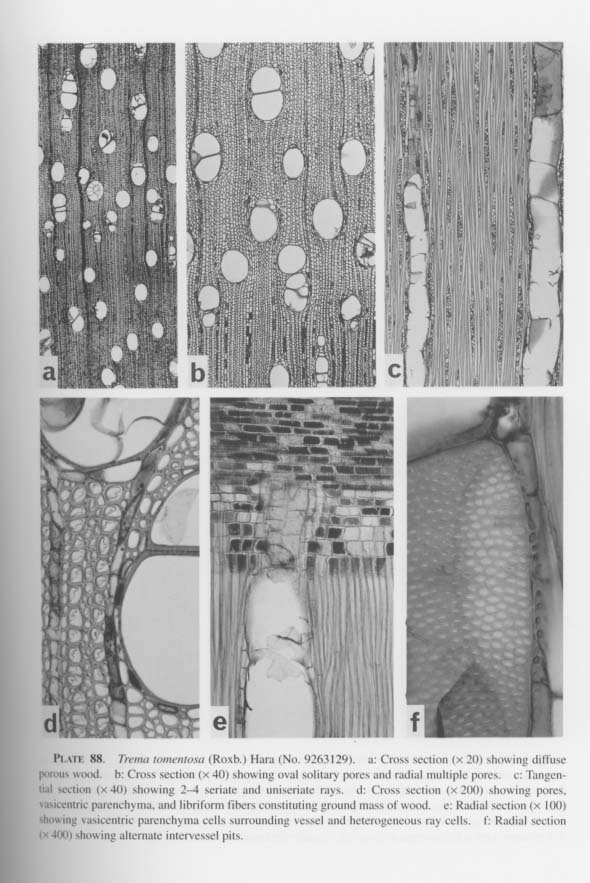
Evergreen small trees in the subtropical and lower temperate zones.
SPECIMENS. No. 9194116, d=25.6 cm, h=6.5 m, alt. 1060 m; Bheri Zone, Kalikot Distr., Badarigaon (1330 m) − Manma (17,10 m) − Karnali Nadi (bridge) (810m) Rengila (850 m) − Kota (810 m), M. Suzuki et al., Aug 6, 1991. No. 9263129*, d=19 cm, h=8 m, alt. 1520 m: Mechi Zone, Taplejung Distr., Chiruwa (1210m) − Tapke Top (1320 m) − Leiep (Tamur bridge) (1460 m) − Thakpa Bazaar (1600 m), M. Suzuki et al., May 22, 1993.
DESCRIPTION. Wood diffuse porous; pores almost same in pore size throughout the wood. Growth rings indistinct, delineated by radially flattened tracheary elements, slightly wide, 3.7-4.0 mm. Pores evenly distributed, few, 5-10 /mm2, mostly solitary, sometimes in radial multiples of 2-4. Solitary pores oval in outline, small to large, 90-290 × 70-200 µm; walls 1-3 µm thick.
Vessel elements short to medium, 200-610 µm; end walls horizontal to oblique; perforation plates exclusively simple. Intervessel pits alternate and dense, circular or horizontally elliptic, 4-12 µm in diameter, with lenticular apertures. Spiral thickenings absent. Tyloses present.
Non-perforated tracheary elements libriform fibers, constituting ground mass of wood, round or polygonal in cross section, 5-30 µm in diameter; walls 1-4 µm thick; simple pits mostly on radial walls, sparse and minute slit-like; spiral thickenings absent.
Wood parenchyma vasicentric; strands mostly consisting of 4-7 cells; cells 20-60 µm in tangential diameter, 40-300 µm tall. Crystals absent.
Rays heterogeneous, uniseriate and 2-4 seriate, 8-12 rays/mm in tangential section. Uniseriate rays 1-13 cells and 50-420 µm tall, consisting of square and upright cells. Multiseriate rays 20-50 µm wide, 175-975 µm tall, consisting of procumbent, square, and upright cells, with uniseriate marginal wings of 1-8 cells. Procumbent cells elliptic in tangential section, 12-28 × 7-18 × 35-95 µm. Square and upright cells elliptic or oblong in tangential section, 30-80 × 10-20 × 15-45 µm. Ray vessel pits circular or horizontally elliptic, 3-15 µm. Dark gum present in ray cells. Crystals absent.
UImus chumlia Melville et Heybroek [Plate 89]
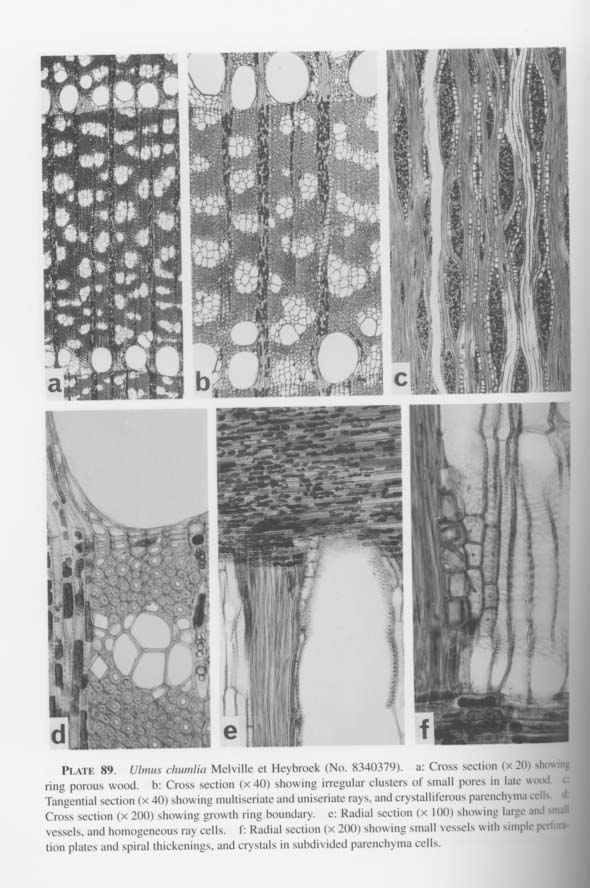
Deciduous trees in the temperate zone.
SPECIMENS. No. 8340376, d=70 cm, h=15 m, alt. 1330 m: Gandaki Zone, Lamjung Distr., Jagat (1300 m.) − Bahundanga (1300 m), H. Ohba et al., Aug. 9, 1983. No. 8340379*, d=35 cm, h=15 m, alt. 1330 m: Gandaki Zone, Lamjung Distr., Jagat (1300 m) − Bahundanga (1300 m), H. Ohba et al., Aug. 9, 1983. No. 9194242, d=4.8 cm, h=1.5 m, alt. 1530 m: Seti Zone, Bajhang Distr., Kinara (1390 m) − (1540 m) − Agra (1360 m) − Jaltadi (1330 m) − Bopur (1330 m) − Chainpur (1310 m), M. Suzuki et al., Aug 24, 1991.
DESCRIPTION. Wood ring porous; growth rings distinct, delineated by the ring porosity and radially flattened tracheary elements at margin of growth rings, narrow to slightly wide, 0.7-3.4 mm. Large pores mostly solitary, occasionally in tangential or radial couples, in 1 or 2 rows at beginning of growth rings, round to oval in outline, 175-380 × 160-340 µm; walls 2-4 ×m thick. Pore size reduced abruptly from early to late wood. Small pores usually in irregular clusters of 6-15 or more, arranged in tangential or oblique pattern in late wood.
Vessel elements short, 140-380 µm; end walls nearly horizontal to moderately oblique; perforation plates exclusively simple. Intervessel pits alternate and dense, circular or polygonal, 7-12 µm in diameter, with small lenticular apertures. Spiral thickenings present on inner walls of small vessel elements, Tyloses absent.
Non-perforated tracheary elements fiber tracheids; constituting ground mass of wood, polygonal in cross section, 6-25 µm in diameter; walls fairly thick, 2-6 µm; bordered pits mostly on radial walls, sparse, minute (about 1-2 µm) or almost no borders, with oblique slit-like apertures; spiral thickenings absent.
Wood parenchyma vasicentric, especially abundant in initial zones of growth rings; strands mostly consisting of 2-5 cells; cells 15-25 µm in tangential diameter, 65-285 µm tall. Rhomboidal crystals present in subdivided crystalliferous cells, abundant.
Rays homogeneous, uniseriate and (2)-3-8 seriate, 4-6 rays/mm in tangential section. Uniseriate rays 1-10 cells and 40-185 µm tall, usually consisting of procumbent cells, rarely square cells intermingled. Multiseriate rays (20)-40-110 µm wide, 200-860 µm tall, usually consisting of procumbent cells, with uniseriate marginal wings of 1-3-(8) procumbent, rarely square cells. Procumbent cells round or elliptic in tangen tial section, 9-33 × 7-25 × 47-240 µm. Ray vessel pits circular or horizontally elliptic, 3-8 µm. Dark gum present in ray cells. Crystals absent.
Ulmus lanceifolia Roxb. ex Wall. [Plate 90]
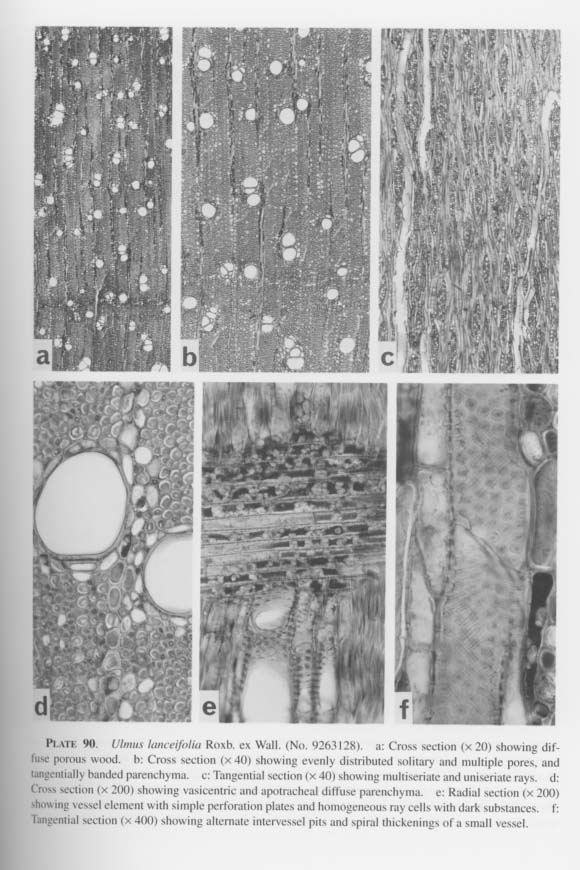
Evergreen trees in the subtropical and lower temperate zones.
SPECIMENS. No. 9263128*, d=20 cm, h=7 m, alt. 1420 m: Mechi Zone, Taplejung Distr., Chiruwa (1210m) − Tapke Top (1320 m) − Leiep (Tamur bridge) (1460 m) −Thakpa Bazaar (1600 m), M. Suzuki et al., May 22, 1993.
DESCRIPTION. Wood diffuse porous. Growth rings absent. Pores evenly distributed, 14-45 /mm2, solitary and in radial multiples of 2-4, occasionally in clusters. Solitary pores round, rarely polygonal in outline, small to medium, 30-130 × 40-150 µm; walls 2-4 µm thick.
Vessel elements short, 120-270 µmm; end walls slightly to moderately oblique; perforation plates exclusively simple. Intervessel pits alternate and dense, circular, 7-10 µmm in diameter, with horizontal lenticular apertures. Spiral thickenings present, distinct, Tyloses absent.
Non-perforated tracheary elements libriform fibers, constituting ground mass of wood, round or polygonal in cross section, 5-20 µm in diameter; walls fairly thick, 2-6 µmm; simple pits mostly on radial walls, sparse and minute slit-like; spiral thickenings absent.
Wood parenchyma fairly abundant, vasicentric, apotracheal diffuse, tangential band one cell wide; strands mostly consisting of 2-4 cells; cells 12-30 µm in tangential diameter, 30-200 µm tall. Rhomboidal crystals present in subdivided crystalliferous cells.
Rays homogeneous, uniseriate and 2-5 seriate, 5-8 rays/mm in tangential section. Uniseriate rays 1-8 cells, 40-175 µm tall, usually consisting of procumbent cells, rarely square cells intermingled. Multiseriate rays 18-60 µm wide, 120-340 µm tall, usually consisting of procumbent cells, with uniseriate marginal wings of 1 or 2 procumbent, rarely square cells. Procumbent cells round or elliptic in tangential section, 8-33 × 6- 18 × 60-180 µm. Ray vessel pits circular or elliptic, 4-9 µm. Dark gum present in ray cells. Crystals absent.
Ulmus wallichiana Planch. [Plate 91]
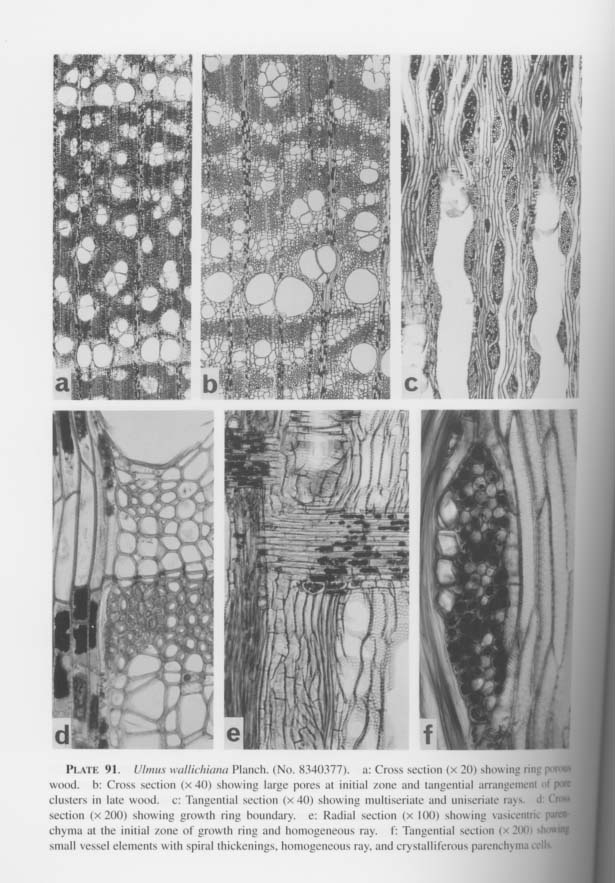
Deciduous trees in the upper temperate zone.
SPECIMENS. No. 8340377*, d=15 cm, h=4 m, alt, 1330 m: Gandaki Zone, Lamjung Distr., Jagat (1300 m) − Bahundanga (1300 m), H. Ohba et al., Aug. 9, 1983. No. 9194224, d=139.5 cm, h=30 m, alt. 2470 m; Seti Zone, Bajhang Distr,, Dhalaun (2400 m) − a pass (2880 m) − Ghat Khola (bridge) (1980 m) − Jima (2230 m) − Rasa (2260 m), M. Suzuki et al., Aug 20, 1991.
DESCRIPTION. Wood ring porous; growth rings distinct, delineated by the ring porosity and radially flattened tracheary elements at margin of growth rings, narrow to a little wide, 0.3-3.4 mm. Pores 40-80/mm2, reduced in size gently from early to late wood. Large pores in 1 or 2 rows in early wood, mostly solitary, sometimes in tangential and radial couples, round to oval in outline, 150-320 × 155-325 µm, walls fairly thick, 2-6 µm. Small pores in late wood in irregular clusters of 4-8 or
more arranged in tangential or oblique pattern.
Vessel elements short, 80-300 µm; end walls nearly horizontal to moderately oblique; perforation plates exclusively simple. Intervessel pits alternate and dense, circular or polygonal, 7-10 µm in diameter, with small horizontal lenticular apertures. Spiral thickenings distinct on inner walls of small vessel elements. Tyloses present.
Non-perforated tracheary elements libriform fibers; constituting ground mass of wood, round or polygonal in cross section, 4-22 µm in diameter; walls 2-4 µm thick; pits mostly on radial walls, sparse, minute (1-2 µm) with oblique slit-like apertures; spiral thickenings absent.
Wood parenchyma vasicentric and apotracheal diffuse, especially abundant in initial zones of growth rings; strands mostly consisting of 2-5 cells; cells 10-28 µm in tangential diameter, 55-170 µm tall. Rhomboidal crystals present in subdivided crystalliferous cells, fairly abundant.
Rays homogeneous, uniseriate and multiseriate, 2-7 cells wide, 4-7 rays/mm in tangential section. Uniseriate rays (1)-2-12 cells and 30-210 µm tall, usually consisting of procumbent cells, rarely square cells intermingled. Multiseriate rays 20-85 µm wide, 100-515 µm tall, usually consisting of procumbent cells, with uniseriate marginal wings of 1-2-(6) procumbent, rarely square cells. Procumbent cells round or elliptic in tangential section, 10-30 × 7-23 × 37-225 µm. Ray vessel pits circular or elliptic, 5-10 µm. Dark gum present in ray cells. Crystals absent.
FAGACEAE (Akira TAKAHASHI, Joshi LAJMINA and Mitsuo SUZUKI)
Castanopsis hystrix Miq. [Plate 92]
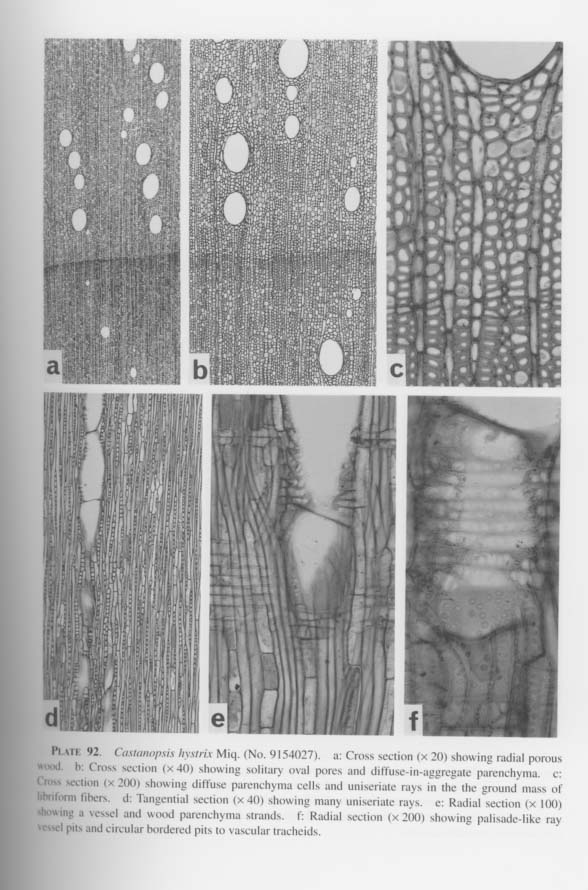
Evergreen trees in the temperate zone.
SPECIMENS. No. 9154027*, d=1.4 cm, h=24 m, alt. 2330 m: Koshi Zone, Khankuta Distr.,Shidua (2140 m)−Tute (2340 m), H. Ohba et al., July 13, 1991.
DESCRIPTION. Wood radial porous; solitary pores arranged in radial or oblique pattern; pore size gradually reduced from early to late wood. Growth rings distinct, delineated by radially flattened tracheary elements, fairly wide, 7 mm. Pores very few, 0-6 /mm2, commonly solitary, oval in outline, 50-290 × 50-220 µm; walls 2-3 µm thick.
Vessel elements short, 240-570 µm; end walls nearly horizontal to moderately oblique; perforation plates exclusively simple. Pits to vascular tracheids alternate, circular or horizontally elliptic, 8-15 µm in diameter, with lenticular apertures. Spiral thickenings and tyloses absent.
Non-perforated tracheary elements vascular tracheids and fiber tracheids. Vascular tracheids wholly surrounding vessel elements, flattened in cross section, thin-walled; pits circular or horizontally elliptic bordered, 7-12 µm in diameter, with lenticular apertures. Fiber tracheids constituting ground mass of wood, round or polygonal in outline, 10-30 µm in diameter, thin to thick walled (2-5 µm); pits mostly on radial walls, sparse, circular bordered, 3-6 µm in diameter, with oblique slit-like apertures. Spiral thickenings absent in either element.
Wood parenchyma apotracheal, abundant, diffuse and diffuse-in-aggregate; strands mostly consisting of 5-8 cells; cells 12-38 µm in diameter, 65-550 µm tall. Pits to vessel elements oval to horizontally elongated, 10-25 µm. Crystals absent.
Rays homogeneous, mostly uniseriate, sometimes biseriate, 12-16 rays/mm in tan gential section. Uni- and biseriate rays 1-26 cells and 25-830 µm tall, mostly consisting of procumbent cells, square cells (30-75 µm tall) occasionally intermingled at margins. Procumbent cells round, elliptic or oblong in tangential section, 13-42 × 10-25 × 70-230 µm. Ray vessel pits various in shape and size, oval or kidney shaped; vertically elongated pits often arranged in palisade pattern, 5-25 µm in diameter, sometimes uni-laterally compound.
Castcmopsis indica (Roxb.) Miq. [Plate 93]
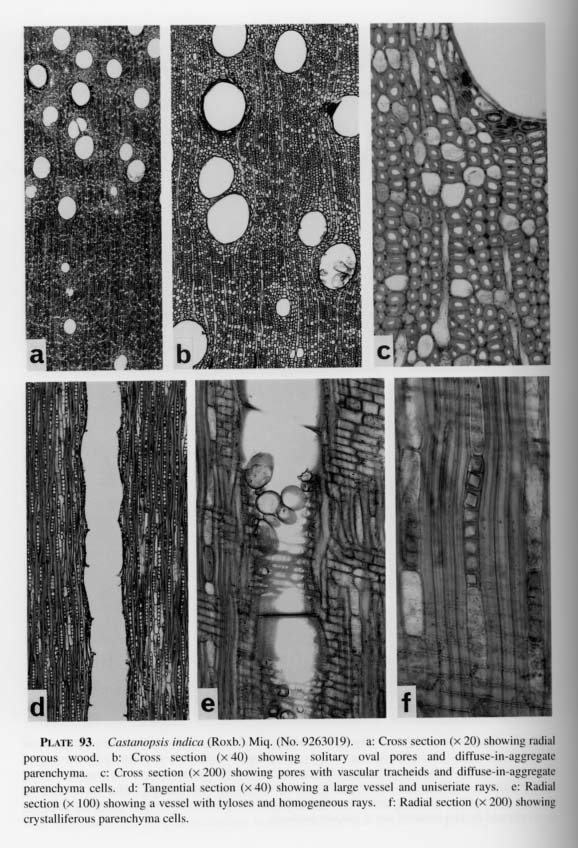
Evergreen trees in the lower temperate zone.
SPECIMENS. No. 8340041, d= − cm, alt. 1210 m: Gandaki Zone, Kaski Distr., Pokhara (950 m) − Suiket (1230 m), H. Ohba et al., July 6, 1983. No. 8840073, d=18 cm, h=11 m, alt. 1230 m: Koshi Zone, Sankhuwasabha Distr., Khandbari (1150 m) − Bhotebas (1800 m), M. Suzuki et al., July 7, 1988. No. 8840137, d=30 cm, h=10 m, alt. 1210 m: Koshi Zone, Sakuwasabha Distr., Nuro (1540 m) − Arun Nadi (730 m), M. Suzuki et al., July 11, 1988. No. 8840398, d=28 cm, h=13 m, alt. 1180 m: Gandaki Zone, Kaski Distr., Pokhara (900 m) − Naudanda Phedi (1150 m), M. Suzuki et al., Aug 18, 1988. No. 9263019*, d=62 cm, h=13 m, alt. 1340 m: Mechi Zone, Taplejung Distr., Khokling (1370 m) − Libang (1220 m) − Thunglung (1560 m), M. Suzuki et al., May 12, 1993.
DESCRIPTION. Wood radial porous; solitary pores arranged in radial or oblique pattern; pore size gradually reduced from early to late wood, but often varying independently of growth rings. Growth rings distinct, occasionally indistinct, delineated by radially flattened tracheary elements, fairly wide, 6.5 mm. Pores very few, 0-6 /mm2, commonly solitary, oval in outline, 75-350 × 60-260 µm; walls 3-7 µm thick.
Vessel elements short to medium, 220-660 µm; end walls nearly horizontal to moderately oblique; perforation plates exclusively simple. Pits to vascular tracheids alternate, circular or horizontally elliptic, 7-10 µm in diameter, with lenticular apertures. Spiral thickenings absent. Tyloses present, abundant.
Non-perforated tracheary elements vascular tracheids and fiber tracheids. Vascular tracheids wholly surrounding vessel elements, flattened in cross section, thin-walled; pits circular or horizontally elliptic bordered, 6-80 µm in diameter, with lenticular apertures. Fiber tracheids constituting ground mass of wood, round or polygonal in outline, 8-28 µm in diameter, thin to thick walled (2-5 µm); pits mostly on radial walls, sparse, circular bordered, 3-5 µm in diameter, with oblique slit-like apertures. Spiral thickenings absent in either element.
Wood parenchyma apotracheal, abundant, diffuse and diffuse-in-aggregate; strands mostly consisting of 5-8 cells; cells 12-30 µm in diameter, 85-190 µm tall. Pits to vessel elements oval to horizontally elongated, 6-20 µm. Rhomboidal crystals present, few, in subdivided crystalliferous cells.
Rays homogeneous, mostly uniseriate, sometimes biseriate, 11-15 rays/mm in tangential section. Uni- and biseriate rays 1-25 cells and 30-530 µm tall, mostly consisting of procumbent cells, square cells (40-45 µm tall) occasionally intermingled at margins. Procumbent cells round, elliptic, or oblong in tangential section, 15-33 × 8-23 × 60-210 µm. Ray vessel pits various in shape and size, oval or kidney shaped; vertically elongated pits often arranged in palisade pattern, 5-20 µm
in diameter, sometimes unilaterally compound.
Castanopsis tribuloides (Sm.) A. DC. [Plate 94]
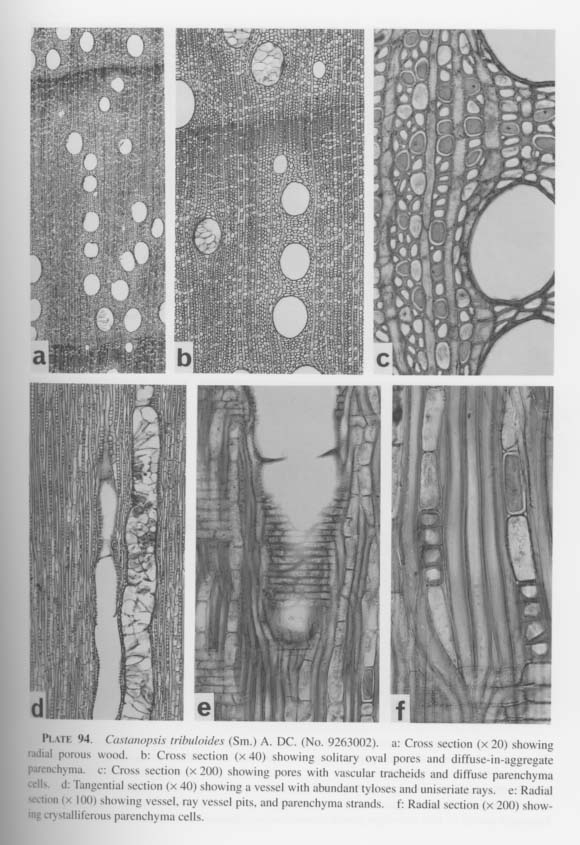
Evergreen trees in the temperate zone.
SPECIMENS. No. 8840085, d=45 cm, h=12 m, alt. 1890 m: Koshi Zone, Sakuwasabha Distr., Bhotebas (1800 m) − Gogane (1870 m) − Chichila (1870 m), M. Suzuki et al., July 8, 1988. No. 8840103, d=35 cm, h=17 m, alt. 1880 m: Koshi Zone, Sakuwasabha Distr., Sakrate (1840 m) − Hurhure (2040 m) − Mude (2040 m), M. Suzuki et al., July 9, 1988. No. 8840139, d=30 cm, h=6 m, alt. 1200 m; Koshi Zone, Sakuwasabha Distr., Num (1540 m) − Arun Nadi (730 m), M. Suzuki et al., July 11, 1988. No. 8840504, d=10 cm, h=4.5 m, alt. 1820 m: Dhawaragiri Zone, Myagdi Distr., Khipang (1740 m) − Paudwar (1900 m), M. Suzuki et al., Aug. 26, 1988. No. 9263002*, d=65cm, h=16 m, alt. 1860 m: Mechi Zone, Taplejung Distr., Suketar (2330 m) − Taplejung (1710 m) − Hangdewa (1500 m) − Mitlung (890 m), M. Suzuki et al., May 10, 1993.
DESCRIPTION. Wood radial porous; solitary pores arranged in radial or oblique pattern; pore size gradually changing in wood. Growth rings distinct, occasionally indistinct, delineated by radially flattened tracheary elements, narrow to a little wide, 1.2-3.5 mm. Pores very few, 3-8 /mm2, commonly solitary, oval in outline, 40-350 × 40-300 µm; walls 2-5 µm thick.
Vessel elements short to medium, 275-600 µm; end walls nearly horizontal to moderately oblique; perforation plates exclusively simple. Pits to vascular tracheids alternate, circular or horizontally elliptic, 7-12 µm in diameter, with lenticular apertures. Spiral thickenings absent. Tyloses present.
Non-perforated tracheary elements vascular tracheids and fiber tracheids. Vascular tracheids wholly surrounding vessel elements, flattened in cross section, thin-walled; pits circular or horizontally elliptic bordered, 7-12 µm in diameter, with lenticular apertures. Fiber tracheids constituting ground mass of wood, round or polygonal in outline, 8-26 µm in diameter, thin to thick walled (2-5 µm); pits on radial and tangential walls sparse, circular bordered, 3-6 µm in diameter, with oblique slit-like apertures. Spiral thickenings absent in either element.
Wood parenchyma apotracheal, abundant, diffuse and diffuse-in-aggregate; strands mostly consisting of 5-8 cells; cells 10-40 µm in diameter, 60-175 µm tall. Pits to vessel elements oval to horizontally elongated, 7-20 µm. Rhomboidal crystals present, few, in subdivided crystalliferous cells.
Rays homogeneous, mostly uniseriate, occasionally biseriate, 10-15 rays/mm in tangential section. Uni- and biseriate rays 1-28 cells and 25-600 µm tall, mostly consisting of procumbent cells, square cells (35-45 µm tall) occasionally intermingled at margins. Procumbent cells round, elliptic or oblong in tangential section, 14-30 × 8-30 × 30-170 ×m. Ray vessel pits various in shape and size, oval or kidney shaped; vertically elongated pits often arranged in palisade pattern, 6-25 µm in diameter, sometimes unilaterally compound.
Lithocarpus elegans (Blume) Hatus. ex Soepadmo [Plate 95]
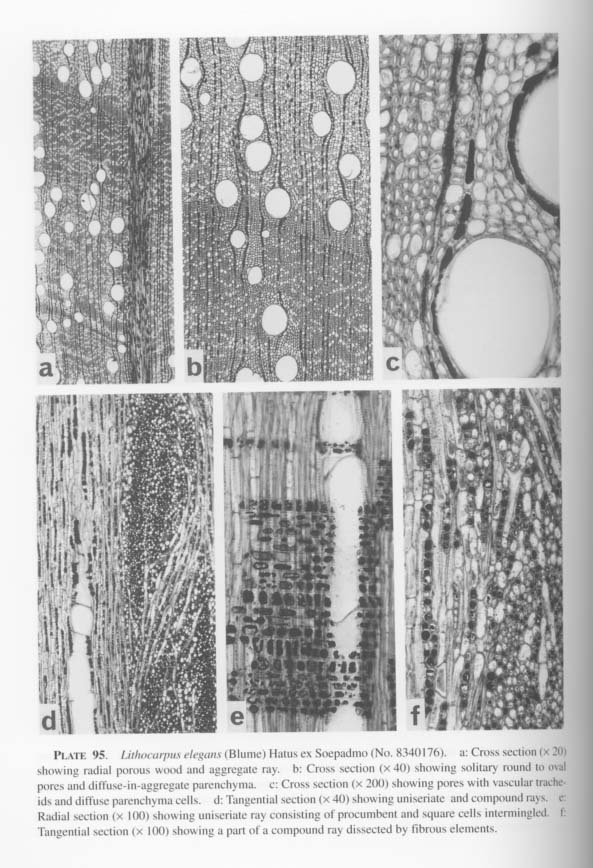
Evergreen trees in the temperate zone.
SPECIMENS. No. 8340176*, d=15 cm, h=6 m, alt. 2050 m: Dhawalagiri Zone, Myagdi Distr., Ghodepani Deolari (2830 m) − Shika (2010 m), H. Ohba et al., July 14, 1983. No. 8340180, d=12cm, h=5 m, alt. 1850 m: Dhawalagiri Zone, Myagdi Distr., Shika (2010 m) − Tatopani(1360 m), H Ohba et al., July 15, 1983. No. 8340181, d=18 cm, h=8 m, alt. 1850 m: Dhawalagiri Zone, Myagdi Distr., Shika (2010 m) − Tatopani (1360 m), H. Ohba et al., July 15, 1983. No. 8840071, d=15 cm, h=9 m, alt. 1180 m: Koshi Zone, Sankhuwasabha Distr., Khandbari (1150 m) − Bhotebas (1800 m), M. Suzuki et al., July 7, 1988. No. 8840394, d=20 cm, h=15 m, alt. 1950 m: Koshi Zone, Sankhuwasabha Distr., Num (1540 m) − Chichila (1870 m), M. Suzuki et al., Aug 3, 1988. No. 8840505, d=12 cm, h=4.5 m, alt. 1820 m: Dhawaragiri Zone, Myagdi Distr., Khipang (1740 m) − Paudwar (1900 m), M. Suzuki et al., Aug. 26, 1988.
DESCRIPTION. Wood radial porous; solitary pores arranged in radial or oblique pattern; pore size gradually change within growth rings. Growth rings distinct, occasionally indistinct, delineated by radially flattened tracheary elements, narrow to a little wide, 1.6-4.0 mm. Pores very few, 3-13 /mm2, commonly solitary, oval in outline, 50-300 × 40-240 µm; walls 3-8 µm thick.
Vessel elements short to medium, 260-670 µm; end walls slightly to moderately oblique; perforation plates exclusively simple. Pits to vascular tracheids alternate, circular or horizontally elliptic, 5-8 µm in diameter, with lenticular apertures. Spiral thickenings and tyloses absent.
Non-perforated tracheary elements vascular tracheids and fiber tracheids. Vascular tracheids wholly surrounding vessel elements; bordered pits circular or horizontally elliptic, 5-8 µm in diameter, with lenticular apertures. Fiber tracheids constituting ground mass of wood, round or polygonal in outline, 5-28 µm in diameter, thin- to thick-walled (2-5 µm); bordered pits sparse, circular, 3-6 µm in diameter, with oblique slit-like apertures. Spiral thickenings absent in either element.
Wood parenchyma apotracheal, abundant, diffuse and diffuse-in-aggregate, tending to narrow tangential bands; strands mostly consisting of 4-7 cells; cells 10-36 µm in tangential diameter, 65-200 µm tall. Pits to vessel elements oval to horizontally elongated, 5-15 µm. Rhomboidal crystals present, few, in subdivided crystalliferous cells.
Rays heterogeneous, mostly uniseriate, occasionally biseriate, 12-15 rays/mm in tangential section, compound rays also present. Uni- and biseriate rays 1-25 cells and 25-550 µm tall, mostly consisting of procumbent cells, square cells (35-63 µm tall) occasionally intermingled at margins. Procumbent cells round, elliptic or oblong in tangential section, 15-30 × 8-30 × 40-110 µm. Ray vessel pits various in shape and size, oval or kidney shaped; vertically elongated pits often arranged in palisade pattern, 5-20 µm in diameter, sometimes unilaterally compound. Dark brownish gum conspicuous in ray cells. Compound rays 320-550 µm wide, 2-6.5 mm or more tall; cells round or elliptic in tangential section, 5-38 µm in diameter, occasionally dissected by axial elements in parts; rhomboidal crystals present.
Lithocarpus pachyphylla (Kurz) Rehder [Plate 96]
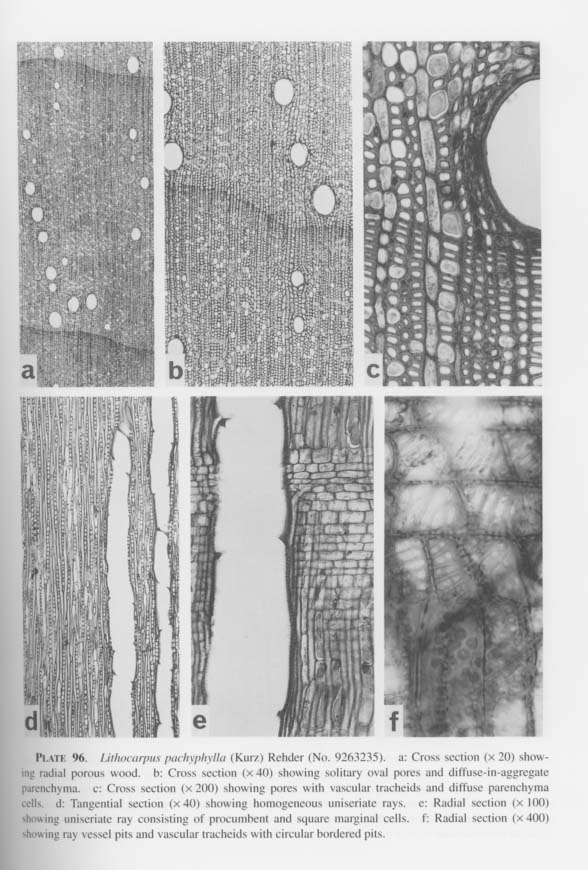
Evergreen trees in the upper temperate zone.
SPECIMENS. No. 9263235*, d=50 cm, h=11 m, alt. 2860 m: Mechi Zone, Panchitar Distr., Gairi Kharka (3270 m) − Phaleke (3350 m) − Lasune Kharka (3110 m) −
deurali (2530 m) − Rabi Khola (1910 m) − Beteni (1980 m), S, Noshiro et al., June 21,1993.
DESCRIPTION. Wood radial porous; solitary pores arranged in radial or oblique pattern. Growth rings distinct, delineated by radially flattened tracheary elements, a little wide, 3.2-4.5 mm. Pores very few, 0-6 /mm2, commonly solitary, oval in outline, 60-250 × 45-185 µm; walls 3-5 µm thick.
Vessel elements medium in length, 300-600 µm; end walls slightly to moderately oblique; perforation plates exclusively simple. Pits to vascular tracheids alternate, circular or horizontally elliptic, 6-9 µm in diameter, with lenticular apertures. Spiral thick-enings and tyloses absent.
Non-perforated tracheary elements vascular tracheids and fiber tracheids. Vascular tracheids wholly surrounding vessel elements; bordered pits circular or horizontally elliptic, 5-8 µm in diameter, with lenticular apertures. Fiber tracheids constituting ground mass of wood, round or polygonal in outline, 7-27 µm in diameter, thin- to thick-walled (2-5 µm); bordered sparse, circular, 3-4 µm in diameter, with oblique slit-like apertures. Spiral thickenings absent in either element.
Wood parenchyma apotracheal, abundant, diffuse and diffuse-in-aggregate, tending to narrow tangential bands; strands mostly consisting of 3-7 cells; cells 12-40 µm in tangential diameter, 70-230 µm tall. Crystals absent.
Rays nearly homogeneous, mostly uniseriate, occasionally biseriate, 13-18 rays/mm in tangential section. Uni- and biseriate rays 1-34 cells and 30-870 µm tall, mostly consisting of procumbent cells, square cells (40-75 µm tall) occasionally intermingled at margins. Procumbent cells round, elliptic or oblong in tangential section, 15-40 × 8-38 × 40-165 µm. Ray vessel pits various in shape and size, oval or kidney shaped; vertically elongated pits often arranged in palisade pattern, 5-27 µm in diameter, sometimes unilaterally compound. Crystals absent.
Quercus floribunda Lindl. ex A.Camus [Plate 97]
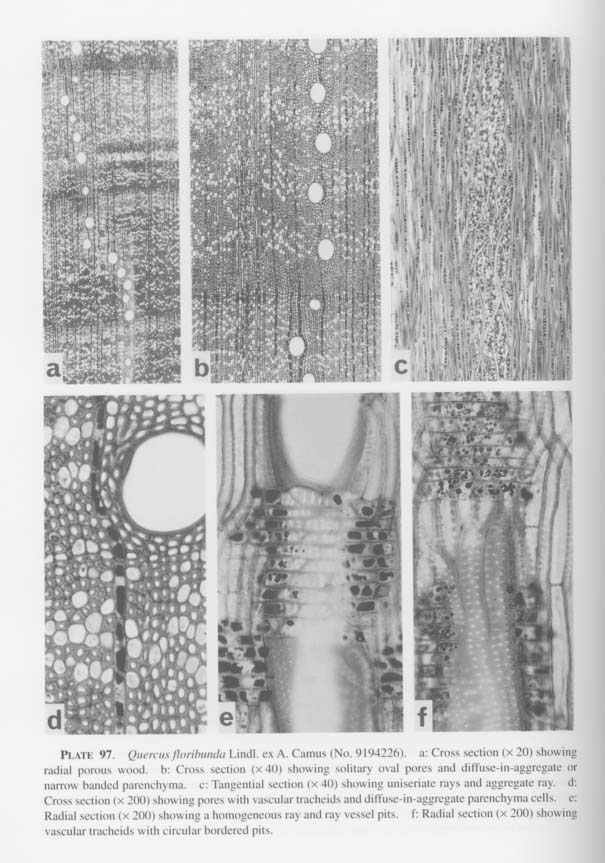
Evergreen trees in the temperate zone.
SPECIMENS. No. 9194226*, d=49.2 cm. h=14 m, alt. 2380 m: Seti Zone, Bajhang Distr., Dhalaun (2400 m) − a pass (2880 m) − Gnat Khola (bridge) (1980 m) − Jima (2230 m) − Rasa (2260 m), M. Suzuki et al., Aug 20, 1991.
DESCRIPTION. Wood radial porous; solitary pores arranged in radial or oblique pattern with vascular tracheids; pore size varying independently of growth rings. Growth rings distinct, occasionally indistinct, delineated by radially flattened tracheary elements, narrow to a little wide, 1.6-3.8 mm. Pores very few, 0-6 /mm2, commonly solitary, oval in outline, 70-190 × 45-150 µm; walls 3-6 µm thick.
Vessel elements short to medium, 250-600 µm; end walls slightly to moderately oblique; perforation plates exclusively simple. Pits to vascular tracheids alternate, circular or horizontally elliptic, 5-8 µm in diameter, with lenticular apertures. Spiral thickenings and tyloses absent.
Non-perforated tracheary elements vascular tracheids and fiber tracheids. Vascular tracheids wholly surrounding vessel elements; bordered pits circular or horizontally elliptic, 6-10 µm in diameter, with lenticular apertures. Fiber tracheids constituting ground mass of wood, round or polygonal in outline, 5-28 µm in diameter, thin- to thick-walled (2-6 µm); bordered pits sparse, circular, 2-5 µm in diameter, with oblique slit-like apertures. Spiral thickenings absent in either element.
Wood parenchyma apotracheal, abundant, diffuse and diffuse-in-aggregate, tending to narrow tangential bands; strands mostly consisting of 3-6 cells; cells 10-30 µm in tangential diameter, 80-220 µm tall. Crystals absent.
Rays homogeneous, mostly uniseriate, occasionally biseriate, 10-16 rays/mm in tangential section, aggregate rays also present. Uni- and biseriate rays 1-25 cells and 25-565 µm tall, mostly consisting of procumbent cells, square cells (30-40 µm tall) occasionally intermingled at margins. Procumbent cells elliptic, rectangular or oblong in tangential section, 15-30 × 7-27 × 42-210 µm. Ray vessel pits various in shape and size, oval or kidney shaped; vertically elongated pits often arranged in palisade pattern, 6-22 µm in diameter, sometimes unilaterally compound. Dark brownish gum conspicuous in ray cells. Aggregate rays 200-330 µm wide, 6.5 mm or more tall; constituent cells round, elliptic, or polygonal in tangential section, 6-35 µm in diameter; crystals absent.
Quercus glauca Thunb. [Plate 98]
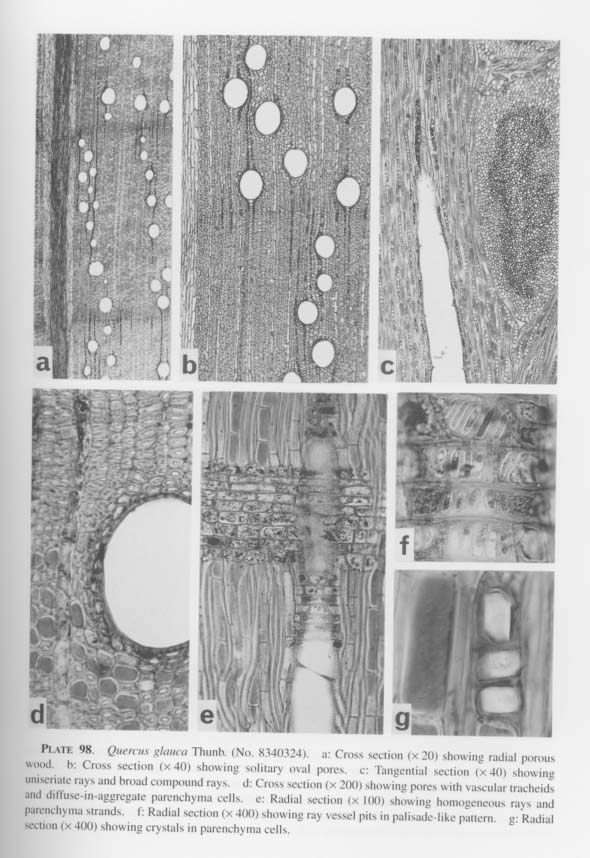
Evergreen trees in the temperate zone.
SPECIMENS. No. 8340322, d=40 cm, h=10 m, alt. 2580 m: Gandaki Zone, Manang Distr., Chame (2630 m) − Thangjo (2580 m), H. Ohba et al., Aug. 6, 1983. No. 8340324*, d=70 cm, h=15 m, alt. 2580 m: Gandaki Zone, Manang Distr., Chame (2630 m) − Thangjo (2580 m), H. Ohba et al., Aug. 6, 1983. No. 9194060, d=40 cm, h=12 m, alt. 900 m: Bheri Zone, Dailekh Distr., Shrithan (790 m) − Bhirkhet (800 m) − Jaljale (820 m) − Rautkot (1130 m) − Koiralagaon (1200 m) − Dandamadi (1220 m), M. Suzuki et al., Aug 2, 1991.
DESCRIPTION. Wood radial porous; solitary pores arranged in radial or oblique pattern with vascular tracheids; pore size varying independently of growth rings. Growth rings distinct, occasionally indistinct, delineated by radially flattened tracheary elements, narrow to a little wide, 0.5-3.5 mm. Pores very few, 0-8 /mm2, commonly solitary, round to oval in outline, 60-260 × 35-220 µm; walls 3-6 µm thick.
Vessel elements short to medium, 280-650 µm; end walls slightly to moderately oblique; perforation plates exclusively simple. Pits to vascular tracheids alternate, circular or horizontally elliptic, 5-8 µm in diameter, with lenticular apertures. Spiral thickenings and tyloses absent.
Non-perforated tracheary elements vascular tracheids and fiber tracheids. Vascular tracheids wholly surrounding vessel elements; bordered pits circular or horizontally elliptic, 5-8 µm in diameter, with lenticular apertures. Fiber tracheids constituting ground mass of wood, round or polygonal in outline, 6-25 µm in diameter, thin- to thick-walled (2-7 µm); bordered pits sparse, circular, 1.5-4 µm in diameter, with oblique slit-like apertures. Spiral thickenings absent in either element.
Wood parenchyma apotracheal, abundant, diffuse and diffuse-in-aggregate, tending to narrow tangential bands; strands mostly consisting of 3-5 cells; cells 10-33 µm in tangential diameter, 75-210 µm tall. Rhomboidal crystals present, few, in subdivided cystalliferous cells.
s homogeneous, mostly uniseriate, occasionally biseriate, 10-14 rays/mm in tan
gential section, large compound rays also present. Uni- and biseriate rays 1-25 cells nd 35-640 µm tall, usually consisting of procumbent cells, square cells (30-50 µm all) occasionally intermingled at margins. Procumbent cells elliptic or oblong in tangential section, 20-35 × 10-38 × 37-155 µm. Ray vessel pits various in shape and size, oval or kidney shaped; vertically elongated pits often arranged in palisade pattern, 6-25 µm in diameter, sometimes unilaterally compound. Dark brownish gum conspicuous in ray cells. Compound rays 350-830 µm wide, 0.8-2.8 mm or more tall; constituent cells round or elliptic in tangential section, 7-45 µm in diameter; intrusion of other axial elements rare; crystals occasionally present.
Quercus lamellosa Sm. [Plate 99]
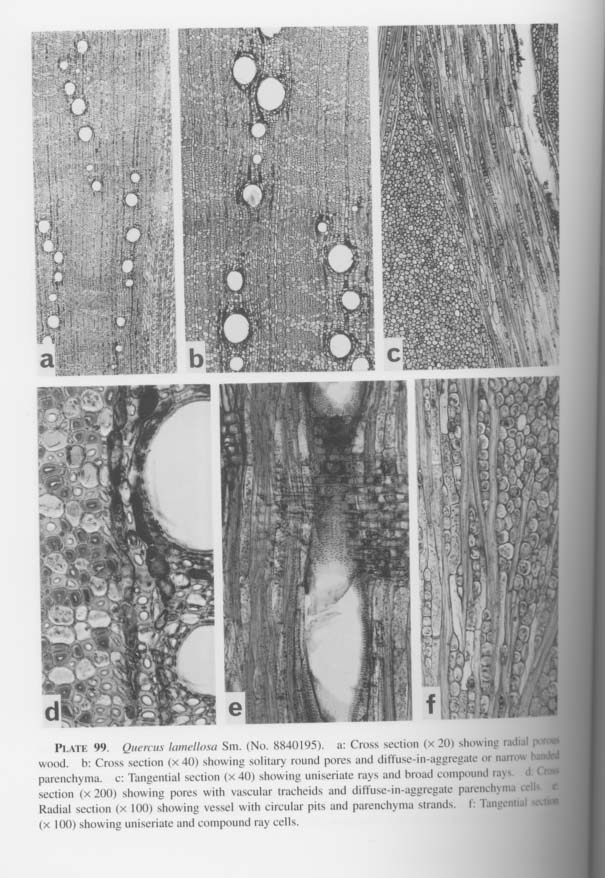
Evergreen trees in the temperate zone.
SPECIMENS. No. 8340064, d= − cm, alt. 1960 m: Gandaki Zone, Kaski Distr., Pothana (1970 m) − Tolka (1750 m), H. Ohba et al, July 8. 1983. No. 8340500, d=60 cm, h=13 m, alt. 2130 m: Janakpur Zone, Dolakha Distr., Phedi Kharaka (2100 m) − Koplang (2100 m), H. Ohba et al., Sept. 14, 1983. No. 8840195*, d=80 cm, h=25 m, alt. 2410 m: Koshi Zone, Sakuwasabha Distr., Uttise Kharaka (2290 m) − Bhainsi Kharaka (2540 m), M. Suzuki et al., July 14, 1988. No. 9263058, d=91 cm, h=18 m, alt. 2210 m: Mechi Zone, Taplejung Distr., Papung (1940 m) − Dongen (2260 m) − Sewaden (2490 m), M. Suzuki et al., May 14, 1993.
DESCRIPTION. Wood radial porous; solitary pores arranged in radial or oblique pattern with vascular tracheids; pore size varying independently of growth rings. Growth rings indistinct, delineated by radially flattened tracheary elements, narrow, 0.2-1.5 mm. Pores very few, 0-8 /mm2, commonly solitary, round to oval in outline, 40-245 × 40-235 µm; walls 3-5 µm. thick.
Vessel elements short to medium, 210-780 µm; end walls slightly to moderately oblique; perforation plates exclusively simple. Pits to vascular tracheids alternate, circular or horizontally elliptic, 4-7 µm in diameter, with lenticular apertures. Spiral thick-enings and tyloses absent.
Non-perforated tracheary elements vascular tracheids and fiber tracheids. Vascular tracheids wholly surrounding vessel elements; bordered pits circular or horizontally elliptic, 4-7 µm in diameter, with lenticular apertures. Fiber tracheids constituting ground mass of wood, round or polygonal in outline, 8-25 µm in diameter, thin- to thick- walled (2-8 µm); bordered pits sparse, circular, 1.5-3 µm in diameter, with oblique slit-like apertures. Spiral thickenings absent in either element.
Wood parenchyma apotracheal, abundant, diffuse and diffuse-in-aggregate, tending to narrow tangential bands; strands mostly consisting of 3-6 cells; cells 12-30 µm in tangential diameter, 80-275 µm tall. Rhomboidal crystals absent, but present in some individuals (No. 9263058).
Rays homogeneous, mostly uniseriate, occasionally biseriate, 7-11 rays/mm in tangential section, compound rays also present. Uni- and biseriate rays 1-22 cells and 40-675 µm tall, usually consisting of procumbent cells, square cells (35-52 µm tall) occasionally intermingled at margins. Procumbent cells elliptic or oblong in tangential section, 20-38 × 7-35 × 50-140 µm. Ray vessel pits various in shape and size, oval or kidney shaped; vertically elongated pits often arranged in palisade pattern, 5-25 µm in diameter, sometimes unilaterally compound. Dark brownish gum present in ray cells. Aggregate rays 350-1000 µm wide, 1.5-9.0 mm or more tall; constituent cells round or elliptic in tangential section, 7-60 µm in diameter; intrusion of other axial elements rare; crystals occasionally present.
Quercus lanata Sm. [Plate 100]
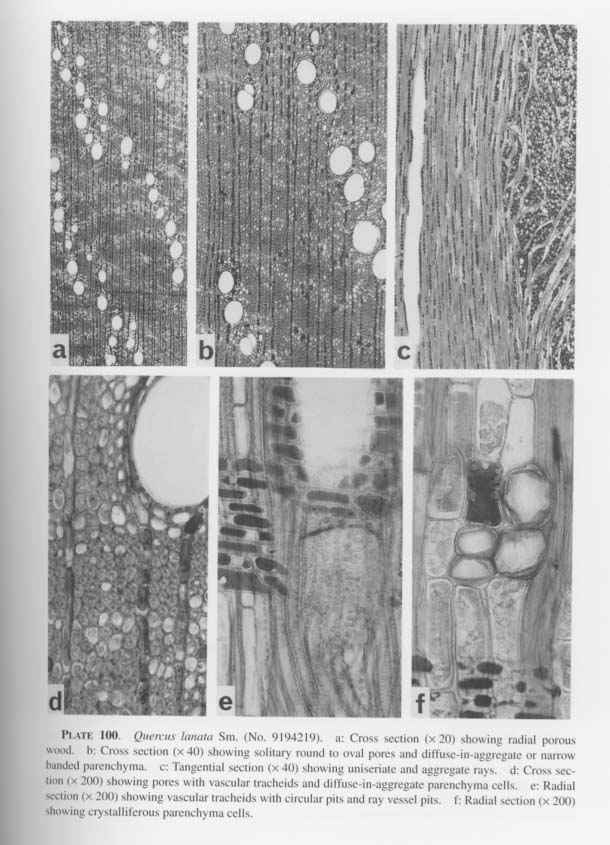
Evergreen trees in the temperate zone.
SPECIMENS. No. 8340438, d=30 cm, h=15 m, alt. 2200 m: Janakpur Zone, Dolakha Distr., Simigaon (1950 m) − Kyalche (2700 m), H. Ohba et al., Aug. 31, 1983. No. 9194219*, d=73.6 cm, h=17 m, alt. 2100 m: Seti Zone, Bajhang Distr., Talkot (1660 m) − Sero (1780 m) − a pass (2070 m) − a river (1960 m) − a pass (2180 m) − Aagar (1840 m), M. Suzuki et al., Aug 18, 1991.
DESCRIPTION. Wood radial porous; solitary pores arranged in radial or oblique pattern with vascular tracheids; pore size varying independently of growth rings. Growth rings distinct, occasionally indistinct, delineated by radially flattened tracheary elements, slightly wide, 3.8-5.2 mm. Pores very few, 0-14 /mm2, commonly solitary, oval in outline, 45-250 × 40-185 µm; walls 2.5-3.5 µm thick.
Vessel elements short to medium, 260-630 µm; end walls slightly to moderately oblique; perforation plates exclusively simple. Pits to vascular tracheids alternate, circular or horizontally elliptic, 7-12 µm in diameter, with lenticular apertures. Spiral thickenings and tyioses absent.
Non-perforated tracheary elements vascular tracheids and fiber tracheids. Vascular tracheids wholly surrounding vessel elements; bordered pits circular or horizontally elliptic, 5-10 µm in diameter, with lenticular apertures. Fiber tracheids constituting ground mass of wood, round or polygonal in outline, 6-20 µm in diameter, thin- to thick-walled (2-8 µm); bordered pits sparse, circular, 2-3 µm in diameter, with oblique slit-like apertures. Spiral thickenings absent in either element.
Wood parenchyma apotracheal, abundant, diffuse and diffuse-in-aggregate, tending to narrow tangential bands; strands mostly consisting of 3-5 cells; cells 10-30 µm in tangential diameter, 75-260 µm tall. Pits to vessel elements scalariform, 6-20 µm in tangential diameter. Rhomboidal crystals present in subdivided crystalliferous cells.
Rays homogeneous, mostly uniseriate, occasionally biseriate, 10-17 rays/mm in tangential section, compound rays also present. Uni- and biseriate rays 1-43 cells and 20-930 µm tall, usually consisting of procumbent cells, square cells (35-45 µm tall) occasionally intermingled at margins. Procumbent cells elliptic or oblong in tangential section, 15-35 × 7-33 × 40-140 µm. Ray vessel pits various in shape and size, oval or kidney shaped; vertically elongated pits often arranged in palisade pattern, 6-28 µm. in diameter, sometimes unilaterally compound. Dark brownish gum present in ray cells. Aggregate rays 350-600 µm wide, 3.0-7.0 mm or more tall; constituent cells round or polygonal in tangential section, 7-38 µm in diameter; crystals occasionally present.
Quercus leucotrichophora A. Camus [Plate 101]
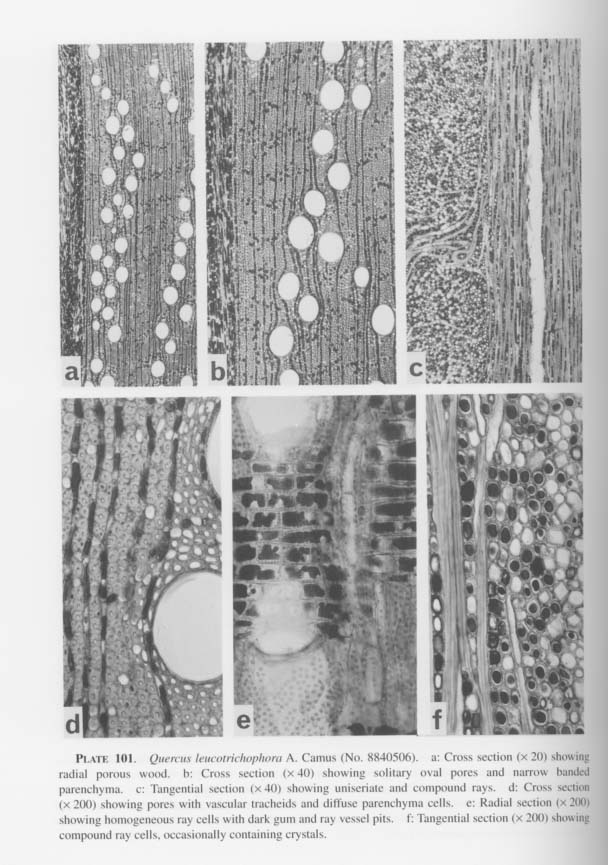
Evergreen trees in the temperate zone.
SPECIMENS. No. 8840506*, d=14 cm, h=7.5 m, alt. 1820 m: Dhawaragiri Zone, Myagdi Distr., Khipang (1740 m) − Paudwar (1900 m), M. Suzuki et al., Aug. 26,
1988. No. 9194063, d=28 cm, h=9 m, alt. 1210 m: Bheri Zone, Dailekh Distr., Dandamadi (1220 m) - Silangi Bazar (1410 m) - Khambagade (1650 m) − Kusapani (1910 m) − Panipokhari (2020 m), M. Suzuki et al., Aug 3, 1991. No. 9194215, d=45 cm, h=12 m, alt. 1690 m: Seti Zone, Bajhang Distr., Badigaon (2230 m) − Dantola (1800 m) − Talkot (1660 m), M. Suzuki et al., Aug 17, 1991.
DESCRIPTION. Wood radial porous; solitary pores arranged in radial or oblique pattern with vascular tracheids; pore size varying independently of growth rings. Growth rings distinct, occasionally indistinct, delineated by radially flattened tracheary elements, narrow, 0.3-2.5 mm. Pores very few, 3-10/mm2, commonly solitary, round to oval in outline, 45-250 × 45-210 µm; walls 2.5-5 µm thick.
Vessel elements short to medium, 200-530 µm; end walls slightly to moderately oblique; perforation plates exclusively simple. Pits to vascular tracheids alternate, circular or horizontally elliptic, 5-7 µm in diameter, with lenticular apertures. Spiral thick-enings and tyloses absent.
Non-perforated tracheary elements vascular tracheids and fiber tracheids. Vascular tracheids wholly surrounding vessel elements; bordered pits circular or horizontally elliptic, 5-7 µm in diameter, with lenticular apertures. Fiber tracheids constituting ground mass of wood, round or polygonal in outline, 5-22 µm in diameter, thin- to thick-walled (2-7 µm); bordered pits sparse, circular, 2-3 µm in diameter, with oblique slit-like apertures. Spiral thickenings absent in either element.
Wood parenchyma apotracheal, abundant, diffuse and diffuse-in-aggregate, tending to narrow tangential bands; strands mostly consisting of 3-8 cells; cells 10-30 µm in tangential diameter, 60-180 µm tall. Pits to vessel elements scalariform, 5-15 µm in tangential diameter. Rhomboidal crystals present in subdivided crystalliferous cells.
Rays homogeneous, mostly uniseriate, occasionally biseriate, 14-18 rays/mm in tangential section, compound rays also present. Uni- and biseriate rays 1-30 cells and 20-650 µm tall, usually consisting of procumbent cells, square cells (37-45 µm tall) occasionally intermingled at margins. Procumbent cells elliptic, rectangular or oblong in tangential section, 17-35 × 7-25 × 50-145 µm. Ray vessel pits various in shape and size, oval or kidney shaped; vertically elongated pits often arranged in palisade pattern, 6-22 µm in diameter, sometimes unilaterally compound. Dark brownish gum present in ray cells. Compound rays 375-625 µm wide, 1.5-4.0 mm or more tall; constituent cells round or polygonal in tangential section, µm in diameter; crystals occasionally present.
Quercus oxyodon Miq. [Plate 102]
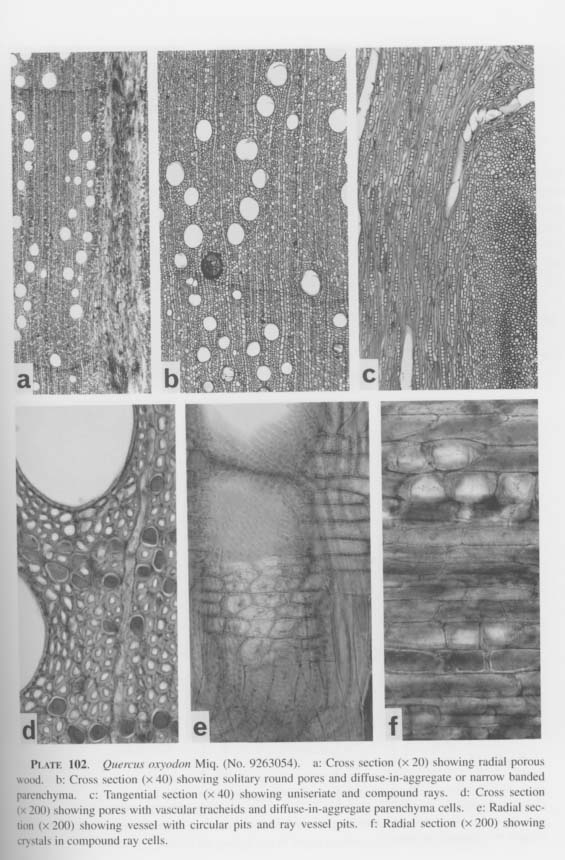
Evergreen trees in the upper temperate zone.
SPECIMENS. No. 8340168, d=30 cm, h=8 m, alt. 2500 m: Dhawalagiri Zone, Myagdi Distr., Ghodepani Deolari (2830 m) − Shika (2010 m), H. Ohba et al., July 14, 1983. No. 8840194, d=70 cm, h=24 m, alt. 2410 m: Koshi Zone, Sakuwasabha Distr., Uttise Kharaka (2290 m) − Bhainsi Kharaka (2540 m), M. Suzuki et al., July 14, 1988. No. 9263054*, d=40 cm, h=11 m, alt. 2280 m: Mechi Zone, Taplejung Distr., Papung (1940 m) − Dongen (2260 m) − Sewaden (2490 m), M. Suzuki et al., May 14, 1993. No. 9263099, d=140 cm, h=18 m, alt. 2330 m: Mechi Zone, Taplejung Distr., Sewaden (2490 m) − Dongen (2260 m) − Papung (1940 m), M. Suzuki et al., May 18, 1993.
DESCRIPTION. Wood radial porous; solitary pores arranged in radial or oblique pattern with vascular tracheids; pore size varying independently of growth rings. Growth rings distinct, occasionally indistinct, delineated by radially flattened tracheary elements, narrow to slightly wide, 0.7-3.4 mm. Pores very few, 3-10/mm2, commonly solitary, round to oval in outline, 40-250 × 35-200 µm; walls 2.5-6 µm thick.
Vessel elements short to medium, 130-540 µm; end walls slightly to moderately oblique; perforation plates exclusively simple. Pits to vascular tracheids alternate, circular or horizontally elliptic, 6-8 µm in diameter, with lenticular apertures. Spiral thickenings and tyloses absent.
Non-perforated tracheary elements vascular tracheids and fiber tracheids. Vascular racheids wholly surrounding vessel elements; bordered pits circular or horizontally lliptic, 5-8 µm in diameter, with lenticular apertures. Fiber tracheids constituting ground ass of wood, round or polygonal in outline, 6-20 µm in diameter, thin- to thick-walled (2-7 µm); bordered pits sparse, circular, 2-3 µm in diameter, with oblique slit-like apertures. Spiral thickenings absent in either element.
Wood parenchyma apotracheal, abundant, diffuse and diffuse-in-aggregate, tending to narrow tangential bands; strands mostly consisting of 3-6 cells; cells 10-35 µm in tangential diameter, 50-180 µm tall. Pits to vessel elements scalariform, 4-22 µm in tangential diameter. Rhomboidal crystals present in subdivided crystalliferous cells.
Rays homogeneous, mostly uniseriate, occasionally biseriate, 11-15 rays/mm in tangential section, compound rays also present. Uni- and biseriate rays 1-20 cells and 40-550 µm tall, usually consisting of procumbent cells, square cells (35-40 µm tall) occasionally intermingled at margins. Procumbent cells round, elliptic, rectangular, or oblong in tangential section, 17-35 × 10-35 × 35-175 µm. Ray vessel pits various in shape and size, oval or kidney shaped; vertically elongated pits often arranged in palisade pattern, 6-30 µm in diameter, sometimes unilaterally compound. Compound rays 250-750 µm wide, 1.5-4.7 mm or more tall; constituent cells mostly round in tangential section, 12-42 µm in diameter; crystals occasionally present.
Quercus semecarpifolia Sm. [Plate 103]
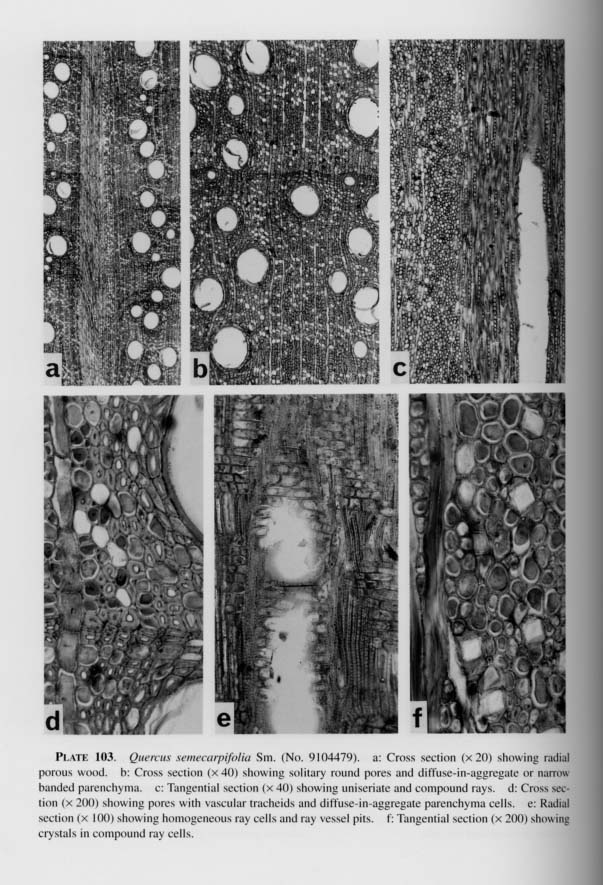
Evergreen trees in the upper temperate and subalpine zones.
SPECIMENS. No. 8340011, d=35 cm, alt. 2760 m: Bagmati Zone, Kathmandu Valley, Mt. Pulchoke, H. Ohba et al., June 30, 1983. No. 8340073, d= − cm, alt. 2040 m: Gandaki Zone, Kaski Distr., Pothana (1970 m) − Tolka (1750 m), H. Ohba et al., July 8, 1983. No. 8340494, d=40 cm, h=15 m, alt. 2930 m: Janakpur Zone, Dolakha Distr., Patale Pokhari (4000 m) − Phedi Kharka (2100 m), H. Ohba et al., Sept, 13, 1983. No. 8540036, d=100 cm, h=16 m, alt. 2450 m: Bagmati Zone, Rasuwa Distr., Syabru (2240 m) − Lama Hotel (2480 m), M. Suzuki & S. Noshiro, May 24, 1985. No. 9104479*, d=100 cm, h=16 m, alt. 2800 m: Karnali Zone, Dolpa Distr., Dunai (2090 m) − Jangra Khora (2170 m) − Khalzala (2240 m) − saddle (2910 m) − Lukhor (2960 m), M. Minaki et al., Oct 11, 1991. No. 9154035, d=60 cm, h=14 m, alt. 2530 m: Koshi Zone, Khankuta Distr., Tute (2340 m) − Tinjure Phedi (2660 m), H. Ohba et al., July 14, 1991. No. 9104030, d=35 cm, h=10 m, alt. 3550 m: Karnali Zone, Jumla Distr., Bibeya (3540 m) − Quadrat #2 (Abies; 3510 m) − Chakare Pani (3670 m) − a saddle (3600 m) − Deula Deuli (3850 m), M. Minaki et al., Sept. 17, 1991.
DESCRIPTION. Wood radial porous; solitary pores arranged in radial or oblique pattern with vascular tracheids; pore size varying independently of growth rings. Growth rings distinct, delineated by radially flattened tracheary elements, narrow, 0.1-1.5 mm. Pores very few, 2-8 /mm2, commonly solitary, round to oval in outline, 55-350 × 55-290 µm; walls 5-9 µm thick.
Vessel elements short to medium, 220-630 µm; end walls slightly to moderately oblique; perforation plates exclusively simple. Pits to vascular tracheids alternate, circular or horizontally elliptic, 7-9 µm in diameter, with lenticular apertures. Spiral thick-enings and tyloses absent.
Non-perforated tracheary elements vascular tracheids and fiber tracheids. Vascular tracheids wholly surrounding vessel elements; bordered pits circular or horizontally elliptic, 6-7.5 µm in diameter, with lenticular apertures. Fiber tracheids constituting ground mass of wood, round or polygonal in outline, 5-30 µm in diameter, thin- to thick-walled (2-8 µm); bordered pits sparse, circular, 2.5-3 µm in diameter, with oblique slit-like apertures. Spiral thickenings absent in either element.
Wood parenchyma apotracheal, abundant, diffuse and diffuse-in-aggregate, tending to narrow tangential bands; strands mostly consisting of 3-8 cells; cells 12-40 µm in tangential diameter, 60-205 µm tall. Rhomboidal crystals present, few, in subdivided crystalliferous cells.
Rays homogeneous, mostly uniseriate, occasionally biseriate, 9-16 rays/mm in tangential section, compound rays also present. Uni- and biseriate rays 1-30 cells and 50-780 µm tall, usually consisting of procumbent cells, square cells (30-45 µm tall) occasionally intermingled at margins. Procumbent cells round, rectangular, or oblong in tangential section, 22-35 × 10-45 × 40-118 µm. Ray vessel pits various in shape and size, oval or kidney shaped; vertically elongated pits often arranged in palisade pattern, 5-22 µm in diameter, sometimes unilaterally compound. Compound rays 250-630 µm wide, 6.0-10 mm or more tall; constituent cells round or polygonal in tangential section, 10-40 µm in diameter; sometimes dissected by axial elements in parts; crystals occasionally present.